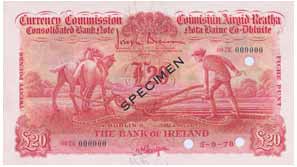
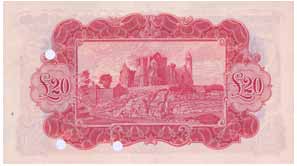
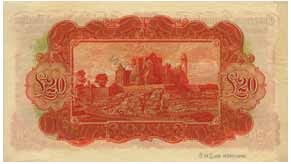
Opened to public access in 2017, The Central Bank of Ireland Archive has provided new source material on the already well-researched Consolidated Bank Notes, commonly known as the 'Ploughman' series. In the text, this is referenced as CBIAR.
The Ploughman Scan Survey (PSS) is a detailed recording of the numbers and grades of the surviving Ploughman notes. PSS has been underway for over 15 years and has lead to a solid data set of over 3,900 banknotes recorded.
In addition to a record of serial numbers issued Ploughman £1, £5, and £10 notes, PSS has recorded by image all instances of Ploughman specimen notes which have appeared over the past 15 years.
Information on the numbers of surviving Ploughman 20 Pound note specimens is maintained and updated periodically in the Ploughman Note Population Report.

![]()
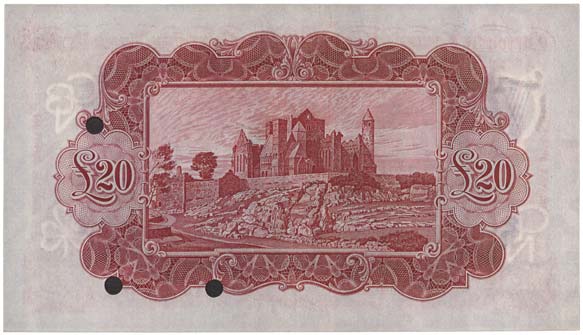
The Consolidated banknotes were designed by artist Dermod O'Brien (1865-1945) [2.].
The Consolidated Bank Note 20 Pound denomination is strongly red in colour, with a yellow underprint. The colour closely matches the colour of the 'Lady Lavery' series 20 Pound Legal Tender Notes which were first issued in 1928 shortly before the Ploughman series in 1929. The Lavery series circulated alongside the Ploughman notes.
All the text on the face of the Ploughman notes is bilingual, in English on the left side and in Irish on the right. The one exception to this is the bank title which is in English only.
The title of the issuing authority is at the top of the note: 'Currency Commission Consolidated Bank Note', 'Coimisiún Airgid Reatha Nóta Bainc Có-Dhlúite'.
The top main signature is that of Joseph Brennan [3.], and is printed centered at the top of the note. His title is below it in very small letters, 'Chairman of the Currency Commission', 'Cathaoirleach Choimisiúin an Airgid Reatha'.
The denomination in words is printed sideways on either side in upper case lettering, 'Twenty Pounds' on the left in English, 'Fiche Punt' in Irish on the right.
At the bottom of the notes is printed in smaller text: 'Payable at the Principle Office in Dublin of', 'Tá so iníoctha ag an bPríomh-Oifig i mBaile Átha Cliath de'.
Under this 'payable at' text is the name of one of the eight Associated Banks which had the right to issue Consolidated Bank Notes. This bank title was added in a separate printing along with the prefix of each banknote which included a letter specific to each bank of issue, called the bank's 'key letter' [CBIAR]. In addition, the bank signatory was added below the bank title in this printing.
In addition to official specimens of the issued note designs in the standard colours, Colour trials of Consolidated Bank Notes without bank titles or dates and serial numbers were printed in a variety of colours. Although rare, examples of these colour trials are offered occasionally. A £20 Ploughman colour trial in purple is illustrated below.
De La Rue specimens were also printed in non-standard colours on paper without watermarks. These were used in the printer's specimen books as examples of their printing, with the notes being glued into the books. All denominations of the Consolidated Bank Notes were printed for these specimen books. The De La Rue Twenty Pound Ploughman specimen note was printed in a strong orange colour. Minor varieties have been recorded of these.
These De La Rue Ploughman printer's specimens tend to be described as colour trials, which they may well be.
As specimens are the only example of higher denomination Ploughman notes available to collectors, when examples of Ploughman Twenty Pound specimens of any type are offered, they tend to fetch high prices.
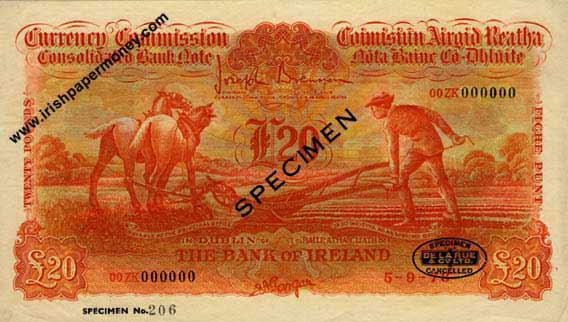
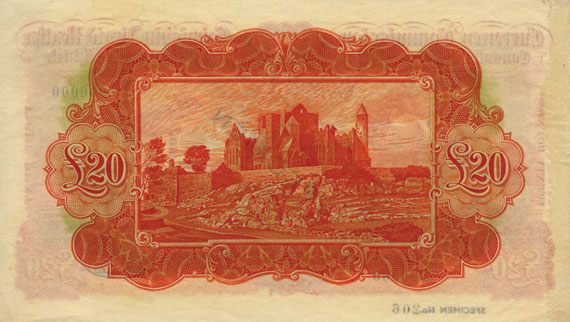

In addition to the official specimen notes in red, examples of the Ploughman Twenty Pound notes are available as De La Rue printers specimens which were printed in orange. Proofs which were also printed without a bank title in various colours
On the reverse of the Ploughman 20 Pound note is an engraving of the Rock of Cashel in county Tpperary. It was constructed over many years ca1100-1270, commencing with the round tower, and with the cathedral being completed by 1270 [4.].

The Rock of Cashel in 2004, a view which is close to that depicted on the reverse of the Ploughman 20 Pound note. [5. Image copyright: Bernie Goldbach 2004. Image source: https://commons.wikimedia.org/wiki/File:Cashel_rock.jpg]
Consolidated Bank Notes had the same dimensions as the Legal Tender Notes. The Ploughman 20 Pound note dimensions are 203 x 114 mm, which can vary slightly by up to 1 or 2 mm in either dimension.
Below is illustrated an example of the first date of a Ploughman 20 Pound note, 6.5.29. This was the only date for the denomination.
The Munster and Leinster Bank is the only issuing bank for which issued notes exist. A small group of the last notes printed were retained by the Central Bank of Ireland along with some £50 and £100 notes.

The notes were printed in several passes. Initially, a multicolored underprint was printed, which was followed by the top printing layer of raised intaglio printing.
The title of the Issuing Authority text on top 'Currency Commission Consolidated Bank Note', 'Coimisiún Airgid Reatha Nóta Bainc Có-Dhlúite' and the signature 'Joseph Brennan' are printed in raised intaglio print which can be easily felt under one's finger, even when the note is well circulated.
In addition the Ploughman notes had a strip of multicolored fibers embedded in the paper at the centre of the note which ran top to bottom, a common security feature of the time, and seen on banknotes of some other countries. The Watermarks and fibre strip are visible in the illustration below.
The Ploughman notes were printed by Thomas De La Rue Limited on watermarked paper manufactured by Portals Limited.
There are four watermarks on the Consolidated Twenty Pound note, one in each corner.
When viewed from the face of the note, the four watermarks on the Ploughman 20 Pound note are as illustrated below: a harp on the left, the three letters 'CBN' interlocked (standing for Consolidated Bank Note) on the right, the letters 'CBN' repeated on the bottom left, and a shamrock on the bottom right. These watermarks are the same on the £20, £50, and £100 denominations.
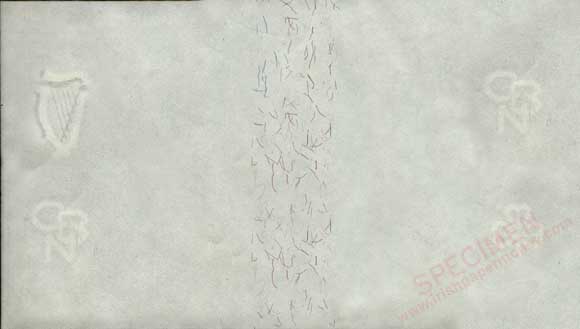
This mock-up image illustrates the positions of the four watermarks on the 20 Pound Consolidated Bank Note. The same layout of watermarks was used on the £50 and £100 notes. In addition, the coloured security fibres embedded in the centre of the paper can be seen

The four watermarks on the Ploughman 20 Pound note are easily visible when the note is viewed from the reverse side
Of the three higher denomination Ploughman notes, the £20 had by far the highest printage and circulation.
Seven of the eight Associated Banks issued Ploughman 20 Pound notes., with only the National Bank not issuing the denomination.
During the 1930s Ploughman 20 notes circulated in sizable quantities.
The quantities of Ploughman £20 notes by bank which are known to have been printed are as follows, taken from Central Bank records [CBIAR].
Bank of Ireland: 6.5.29, 01BX 000001 – 01BX 000100
Hibernian Bank: 6.5.29, 01HX 000001 – 01HX 000100
Munster and Leinster Bank: 6.5.29, 01MX 000001 – 01MX 004000
Northern Bank: 6.5.29, 01OX 000001 – 01OX 003000
Provincial Bank of Ireland: 6.5.29, 01PX 000001 – 01PX 000200
Royal Bank of Ireland: 6.5.29, 01RX 000001 – 01RX 000210
Ulster Bank: 6.5.29, 01UX 000001 – 01UX 000185
Despite their active circulation, no Ploughman £20 notes have survived. The final outstanding note is believed to have been remitted in the early 1970s. Central Bank records indicate that the denomination is fully redeemed.
Ploughman notes ceased production after the Currency Commission Ireland was wound up in 1942 to be replaced by the Central Bank of Ireland in 1943. The banknotes continued to be issued and redeemed by the banks until the end of 1953.
On 31 December 1953 all issues ceased, and the Central Bank of Ireland became the sole issuer of banknotes in Ireland.
All of the Ploughman £20 notes have been redeemed, and there are no issued examples of the denomination outstanding.
However, specimen notes are availablet collectors. There are two types of Ploughman specimen notes, those printed in the standard colours on watermarked paper, and those printed as examples by De La Rue in non-standard colours on paper without watermarks.
All recorded examples of £20 specimens are listed in the Consolidated Bank Note Population Report based on the Ploughman Scan Survey data.
There are 7 signature varieties, one for each bank which issued the Consolidated £20 notes.
Examples of the Munster and Leinster Bank Gubbins signature survive as issued notes in the Central Bank archives; and examples of the Bank of Ireland Gargan signature survive as specimen notes.
Bank of Ireland: Gargan 1929.
Hibernian Bank: Campbell 1929.
Munster & Leinster Bank: Gubbins 1929.
National Bank:
Northern Bank: Knox 1929.
Provincial Bank of Ireland: Robertson 1929.
Royal Bank of Ireland: Stanley 1929
Ulster Bank: Patton 1929.
References [Last retrieved 14.08.24]
1. Central Bank of Ireland Archives.
2. Dermod O'Brien (1865-1945) <https://www.dib.ie/biography/obrien-dermod-a6460p>
3. Joseph Brennan (1887-1976) <https://www.dib.ie/biography/brennan-joseph-a0938>
4. https://www.archiseek.com/rock-of-cashel-co-tipperary/
5. Rock of Cashel, Co Tipperary. Copyright 2004, Bernie Goldbach. Image source: < https://commons.wikimedia.org/wiki/File:Cashel_rock.jpg >, reproduced under the Creative Commons Attribution-Share Alike 2.0 Generic license.
1 Pound Ploughman
5 Pounds Ploughman
10 Pounds Ploughman
20 Pounds Ploughman
50 Pounds Ploughman
100 Pounds Ploughman
Irish Ten Shilling Notes
1 Pound Note Lady Lavery
5 Pounds Lady Lavery
10 Pounds Lady Lavery
20 Pounds Lady Lavery
50 Pounds Lady Lavery
100 Pounds Lady Lavery
1 Pound Note, Queen Medb
5 Pound Note, John Scotus Eriugena
10 Pound Note, Jonathan Swift
20 Pound Note, W. B. Yeats
50 Pound Note, Turlough O'Carolan
100 Pound Note, Grace O'Malley
5 Pound Note, Sister Catherine McAuley
10 Pound Note, James Joyce
20 Pound Note, Daniel O'Connell
50 Pound Note, Douglas Hyde
100 Pound Note, Charles Stewart Parnell
Northen Ireland Polymer notes
Bank of Ireland Polymer Notes
Danske Bank Polymer Notes
Ulster Bank Polymer Notes
Special Sections and Articles
The Transition of Irish Currency, Irish banknotes 1918–1928
The Partition of Irish Currency, Irish banknotes 1928–1930
Banknote Design Evolution 1824 to 1916
Irish Three Pound Notes
Contemporary Forgeries of Early Irish Banknotes, ca1800-1930
Limerick Soviet Notes
Irish World War 2 Banknote Issues
Low Number Irish Banknotes
Irish Joint Stock Banks of Note Issue from 1783
Irish Legal Tender Note Specimens
Ploughman Scan Survey (PSS)
![]() Stable version. Last update 24.08.24.
Stable version. Last update 24.08.24.